|
|
October 20, 2017
Aberrant Transverse Flexion Creases point towards:
'Low Personality Plasticity' (= cognitive inflexibility)
- Aberrant transverse creases in both hands point towards low cognitive stability-
This article presents new results which suggest that all major transverse transverse crease aberrations (simian lines, Sydney lines & Suwon lines) may signal a similar tendency manifesting as an 'inflexible personality', based on a low average score for the Big Five personality dimensions Openness & Extraversion. The results also suggest that this tendency is inclined to manifest stronger in people who have such palmar crease variations in both hands!
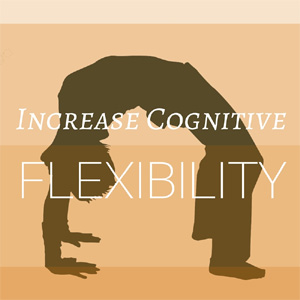 In a sample of 262 Dutch subjects up to 65 subjects (= 25%) have in at least 1 hand a variation of aberrant major transverse creases, which may involve a variant of a simian line, Sydney line or Suwon line. The Big Five personality profiles of these subjects show a major trend pointing in the direction of a manifestation of low personality plasticity (a.k.a. cognitive inflexibility), which involves a low (average) score on the dimensions Openness & Extraversion - which typically represents a conservative introvert. Interestingly, the most extreme variations in terms of personality have been spotted for a small sub-group of subjects who have simian line in one hand + a Sydney line in the other hand! In a sample of 262 Dutch subjects up to 65 subjects (= 25%) have in at least 1 hand a variation of aberrant major transverse creases, which may involve a variant of a simian line, Sydney line or Suwon line. The Big Five personality profiles of these subjects show a major trend pointing in the direction of a manifestation of low personality plasticity (a.k.a. cognitive inflexibility), which involves a low (average) score on the dimensions Openness & Extraversion - which typically represents a conservative introvert. Interestingly, the most extreme variations in terms of personality have been spotted for a small sub-group of subjects who have simian line in one hand + a Sydney line in the other hand!
Additionally, another major trend was spotted: the presence of aberrant creases in both hands is featured with a tendency towards low cognitive stability; which often involves the combination of a low score on the dimensions Agreeableness and Conscientiousness, plus a high score on Neuroticism.
The picture below shows that 10 out of 11 aberrant transverse crease sub-groups score negative for the derived Big Five component 'cognitive flexibility'; also, 9 out of 11 sub-groups have a score beyond -10%, and there is a high level of consistency for the sub-groups involving just simian lines, Sydney lines or Suwon lines. Only the sub-group of subjects with a simian line in both hands has a neutral score (+0,6%) and the sub-group with just a Suwon line in one hand produced only a small negative score (-5,3%).
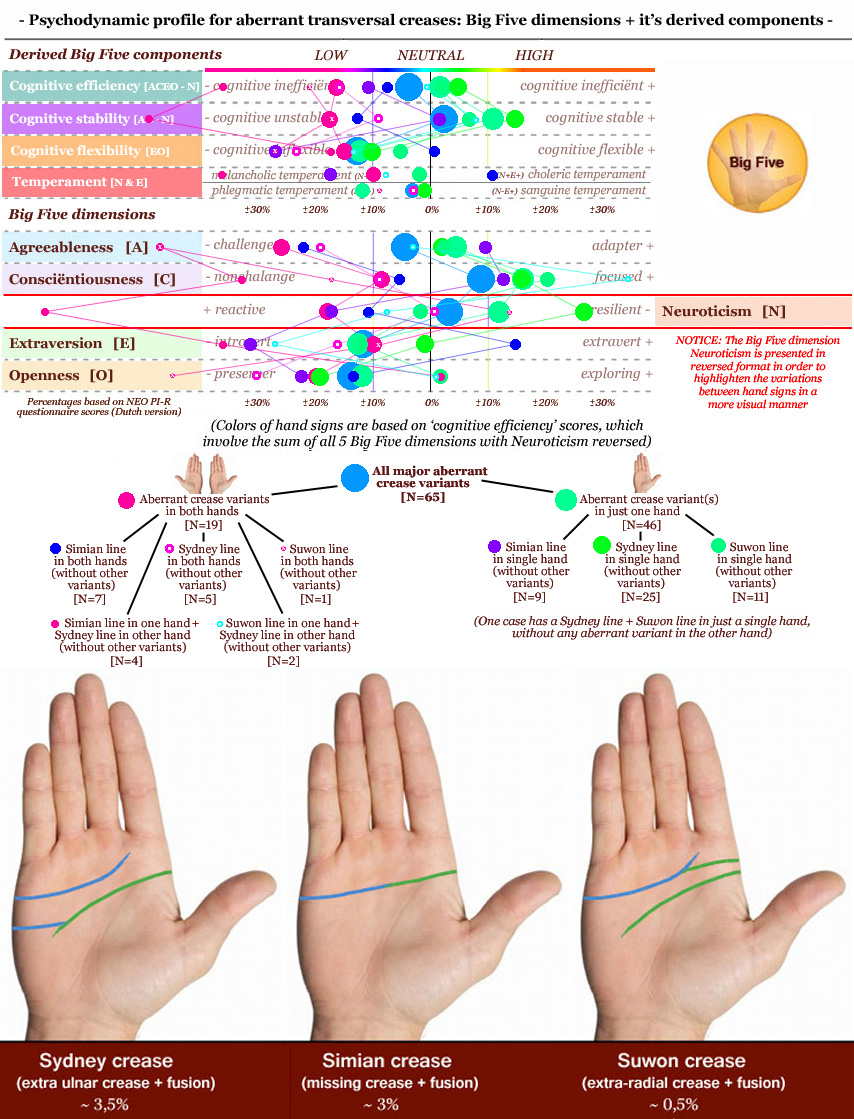
NOTICE: Profiles displayed in the picture above are based on the performance of 262 subjects on the Dutch version
of the NEO PI-R questionnaire; 65 subjects have at least 1 aberrant transverse crease variant,
which may involve: a simian line, Sydney line or Suwon line.
Also, the major sub-group involving aberrant transverse crease in both hands scores beyond -10% for cognitive stability (-17,5%), with all three line-groups have a negative scores; while the sub-group involving aberrant transverse creases in a single hand scores beyond +10 for cognitive stability (+10,8%) - all three line-groups have a positive score.
These results suggest that people with aberrant creases in both hands appear to have a personality constellation pointing in the direction of low cognitive efficiency (-16,5%) - which typically involves low cognitive flexibility combined with low cognitive stability. People with an aberrant crease in a single hand appear to be inclined to have a conforming personality constellation (which can be understood to represent the opposite of a 'rebellious personality') - which typically involves low cognitive flexibility combined with high cognitive stability.
Tendencies for the individual Big Five dimensions and odd major crease combinations (including the combinations: simian line + Sydney line, and Sydney line + Suwon line) are discussed below.
- Tendencies for individual Big Five dimensions? -
In 4 out of 5 Big Five dimensions the average score of the full aberrant transverse crease population is negative; a positive score is only spotted for the dimension Conscientiousness, which can largely be attributed to the sub-groups which have an aberrant crease in just a single hand.
Also, it is interesting to notice that all sub-groups with an aberrant transverse crease in just a single hand have a small but positive average score for the Big Five dimensions Agreeableness - while all sub-groups with an aberrant transverse crease in both hands have a clear negative score, with 5 out of 6 sub-groups scoring beyond -10%.
Only for the dimensions Openness & Extraversion are the average scores for both the 'double hands'- and the 'single hand' group at least -10%; the most apparent contradiction between both groups becomes manifest for the dimension Neuroticism, where the 'double hands' group has a score beyond +10% and the 'single hand' group has a score beyond -10% - which also largely explains the difference between both groups in terms of cognitive stability (with high scores for the 'single hand' group and low scores for the 'double hand' group).
- Tendencies for the individual lines? -
The following represent the most consistent tendencies observed in the sub-populations in each of the three major palmar transverse flexion crease variations:
• Simian lines:
- 6 out of 7 sub-groups with simian lines included score negative for 'cognitive efficiency', which suggests that simian lines appear to have a considerable impact pointing in the direction of cognitive inefficiency (only the 'aberrant line in just one hand' has a small positive score, which does not really undermine here the observed effect);
- 6 out of 7 sub-groups with simian lines included score negative for 'cognitive flexibility', which suggests that simian lines appear to have a considerable impact pointing in the direction of cognitive inflexibility (however, the 'simian lines in both hands' sub-group has actually a high positive score for cognitive flexibility - which suggests that the simian line itself is probably NOT a consistent predictor for low cognitive inflexibility);
- 6 out of 7 sub-groups with simian lines included score negative for Extraversion, which suggests that simian lines appear to have a considerable impact pointing in the direction of an introverted personality (however, the 'simian lines in both hands' sub-group has actually a high positive score for Extraversion - which suggests that the simian line itself is probably NOT a consistent predictor for low Extraversion);
- beyond the result pointing in the direction of cognitive inefficiency', for the 2 most specified simian line groups consistent results are only found pointing in the direction of high Neuroticism and towards low Openness (for both dimensions always with percentages above 10%).
• Sydney lines:
- All 7 sub-groups with Sydney lines included score beyond -10% for 'cognitive flexibility', which suggests that Sydney lines appear to have a significant impact pointing in the direction of cognitive inflexibility;
- All 7 sub-groups with Sydney lines included also score negative for Extraversion, which suggests that Sydney lines appear to have a significant impact pointing in the direction of an introverted personality (6 out of 7 groups score beyond -10%, only the sub-group with a Sydney line in just one hand has a score of -1,0%);
- beyond the results pointing in the direction of cognitive inflexibility & introversion, for the 2 most specified Sydney line groups consistent results are only found pointing in the direction of low Neuroticism and towards low Openness (for the later dimensions with percentages beyond -19%).
• Suwon lines:
- All 7 sub-groups with Suwon lines included score beyond -5% for 'cognitive flexibility', which suggests that Suwon lines appear to have a significant impact pointing in the direction of cognitive inflexibility.
- All 7 sub-groups with Suwon lines included also score beyond -9% for Extraversion, which suggests that Suwon lines appear to have a significant impact pointing in the direction of an introverted personality;
- beyond the results pointing in the direction of cognitive inflexibility and introversion, for the 2 most specified Suwon line groups no consistent results have been found for any of the other Big Five dimensions nor any derived components.
- Tendencies for odd aberrant major line combinations? -
Curiously, the most extreme variations in terms of personality have been spotted for the two relatively rare and odd variation involving the combination of different crease variants in a pair of hands:
• Simian line in 1 hand + Sydney line in the other hand:
All 4 subjects in this sub-group score (very) high for Neuroticism, and the average score for 3 of the other Big Five dimensions is clearly negative (Agreeableness -47,2%, Extraversion -36,3%, and Conscientiousness -32.8%). This results in negative scores (far) beyond -10% for all 3 derived components, and a disposition towards a 'melancholic temperament' (which requires a positive score for Neuroticism combined with a negative score for Extraversion).
• Sydney line in 1 hand + Suwon line in the other hand:
This sub-group involving only 2 subjects has produced the highest positive score seen for any of the 11 sub-populations, which manifests for the dimension Conscientiousness.
This results in a positive score for cognitive stability, which also involves the only positive score for this derived component among the 'double hands' sub-groups.
Finally, the low score for the dimension Extraversion is also remarkable for this group; this factor also explains the negative score for cognitive stability.
- CONCLUSION -
Simian lines, Sydney lines & Suwon creases together represent 3 major categories of aberrant transverse creases, of which only the first two became recognized in the perspective of medical science to represent examples of 'minor physical anomalies'.
In this study the results suggest that all 3 major categories appear to bare potential to serve in the perspective of personality as a sign of cognitive inflexibility; this tendency was only not confirmed for the group of subjects who have a simian line in both hands (though 3 out of these 7 subjects do have the requirement). The underlying factors are largely explained by a tendency for all 3 major categories to have low average scores for the dimension Extraversion, with a positive score only for the sub-group with a simian line in both hands.
The strongest tendencies seen for the individual lines are as follows:
- simian lines: low cognitive efficiency, high Neuroticism, and low Openness;
- Sydney lines: low cognitive flexibility, low Extraversion, low Neuroticism, and low Openness;
- Suwon lines: low cognitive flexibility, and low Extraversion.
Finally, some strong effects have been spotted for 'odd' combinations:
- simian line in 1 hand + a Sydney line in the other hand: pointing in the direction of very low negative scores for all 3 derived Big Five components - with a high positive score for Neuroticism and high negative scores for Agreeableness, Extraversion, and Conscientiousness;
- Sydney line in 1 hand + Suwon line in the other hand: a striking high positive score for Conscientiousness, and a very high negative score for Extraversion.
Last but not least, in the fields of hand reading [palmistry / palm reading] the theme 'flexibility' (in the perspective of personality) is often associated with the palms and fingers; the results reported here suggest that the (major) 'flexion creases' can be used as well. A recent preceding study involing the minor creases has shown that a high accessory crease density and a low accessory crease density both also produced a negative correlation with 'cognitive flexibily'. This suggests that HIGH cognitive flexibility (personality plasticity) is most likely to be found in people who have normal transverse flexion creases combined with normal accessory crease density... in both hands!
FINAL NOTIFICATION: Low plasticity / cognitive inflexibility can also become manifest through the development of a personality disorder in the 'cluster C', where the combination of low Openness and low Extraversion may typically manifest with an obsessive compulsive disorder.
 SUGGESTIONS FOR FURTHER READING: SUGGESTIONS FOR FURTHER READING:
• Major hand signs & the General Factor of Personality (a.k.a. 'trait EQ')
• Psychodynamic profiles for Simian Line variations
show tendency towards a low 'General Factor of Personality'!
• The Sydney line: an underestimated hand crease!
• The Suwon crease is included inside the 'Hand Sign Tutor'
The illustrations below provide additional insights regarding
the fundamentals of the aberrant creases & the Big Five dimensions + it's derived components
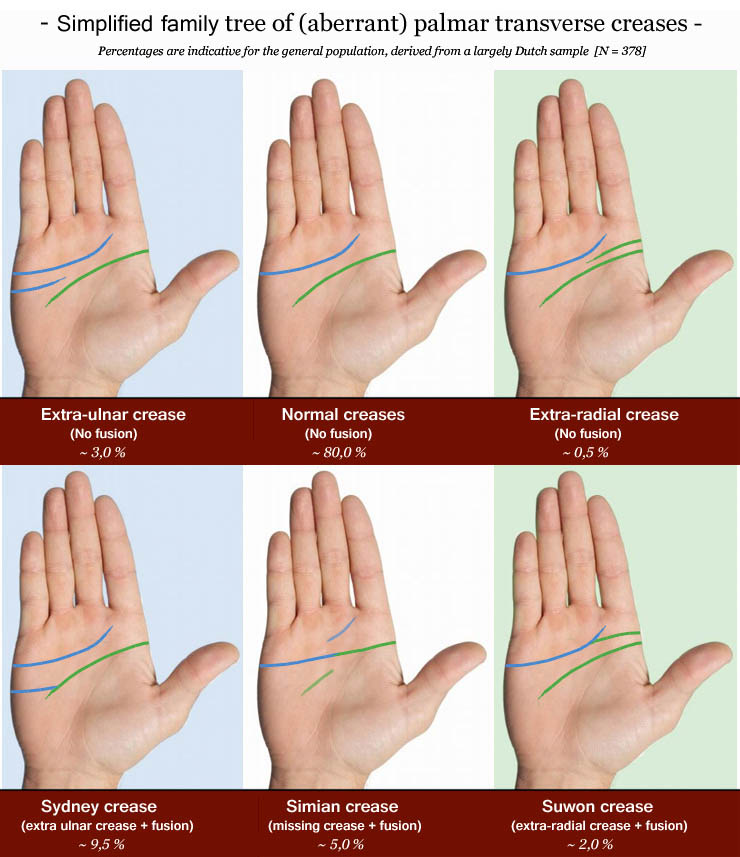
The simplified (above) and advanced (below)
family tree of aberrant palmar transverse creases variations,
including the simian line, Sydney line & Suwon line.
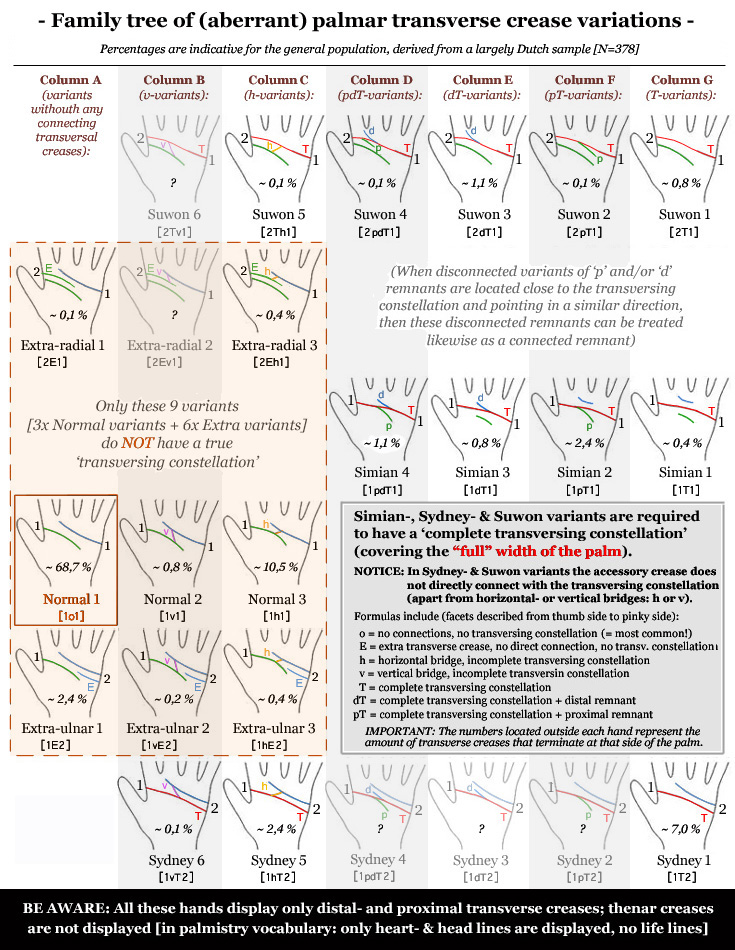
The fundamentals of the Big Five personality dimensions +
it's derived components, featuring: cognitive efficiency, cognitive stability,
cognitive flexibility & temperament.
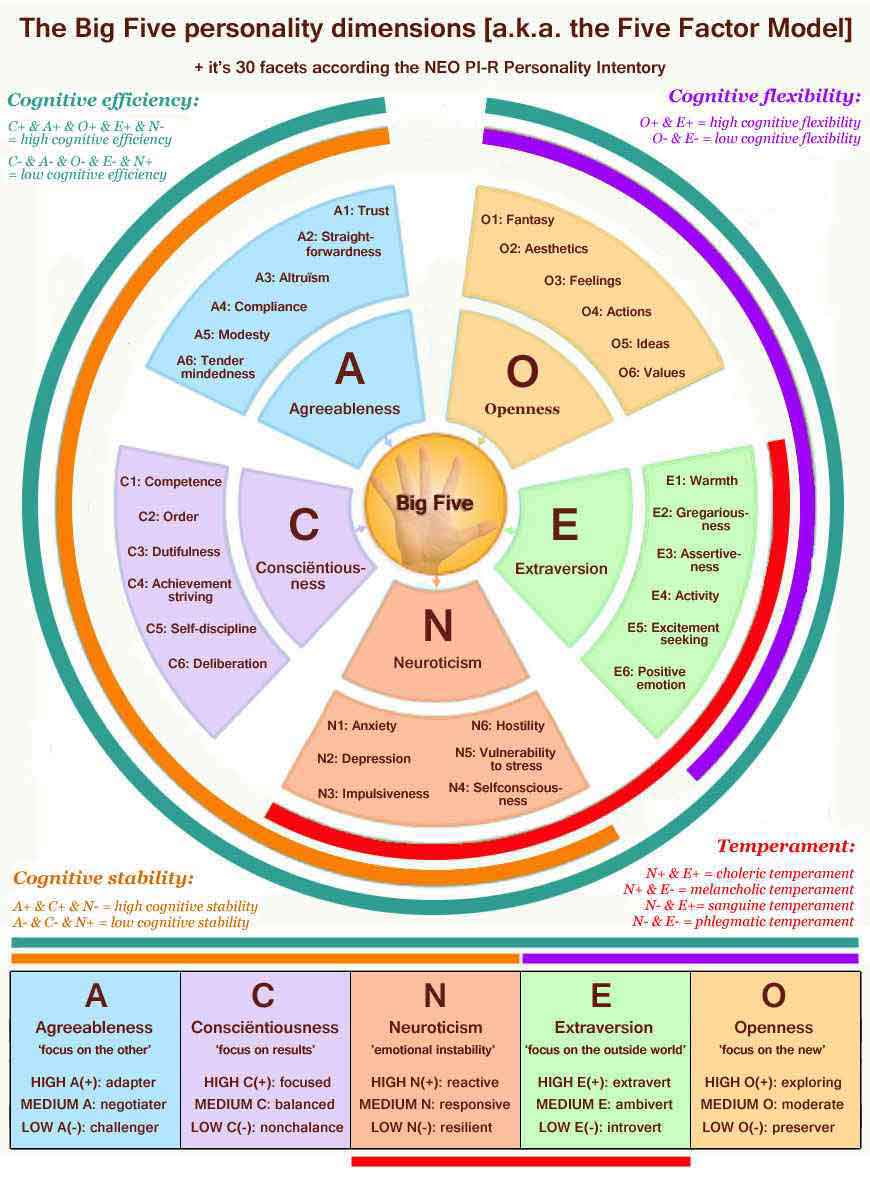
AGREEABLENESS -
CONSCIENTIOUSNESS -
NEUROTICISM -
EXTRAVERSION -
OPENNESS
|
|
|
|